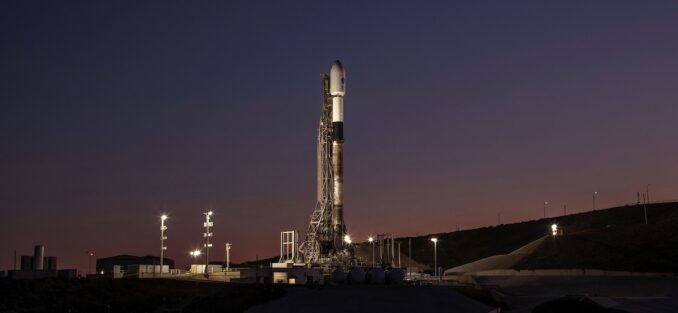
A Falcon 9 rocket lifted off from the West Coast with another batch of satellites for SpaceX’s Starlink network Friday at 12:03 a.m. PST (3:03 a.m. EST / 0803 UTC).
The Starlink 7-8 mission launched from Space Launch Complex 4E at the Vandenberg Space Force Base in California, launched in a southeasterly direction, and aimed for an orbit of 183×178 mi (295×286 km), inclined at 53 degrees to the equator. SpaceX’s webcast ran into technical problems and the liftoff didn’t show. It was six days, 13 hours, 43 minutes and 57 seconds since the last launch from SLC-4E, marking the fastest turnaround for SpaceX’s West Coast launch pad, beating the previous record set on Oct. 29, 2023, by nearly 36 hours.
The first stage booster, making its 13th flight, previously launched NROL-87, NROL-85, Sara-1, SWOT, Transporter-8, Transporter-9 missions. And six previous Starlink delivery missions. After completing its burn, the first stage landed on the drone ship ‘Of Course I Still Love You’, parked about 400 miles downstream (644 km) in the Pacific Ocean off the coast of Baja California.
SpaceX confirmed in a social media post that the deployment of the 22 Starlink satellites would occur an hour after the launch. This is the 40th release of the V2 Mini Starlink model since its launch earlier this year. This new version is much larger than the previous V1.5 satellites and features improved antennas and larger solar panels, and is capable of delivering four times more bandwidth.
SpaceX recently announced earlier this year that it has signed up more than two million subscribers in more than 60 countries for its Starlink Internet service. Ahead of Friday’s Starlink 7-8 mission, it had launched 5,559 satellites, according to figures compiled by Jonathan McDowell, an astronomer at the Harvard-Smithsonian Center for Astrophysics. Space Flight Database. Of these, 5,186 satellites are in orbit and 5,147 appear to be working normally.
